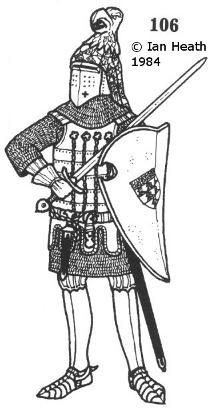
Try Amazon Audible Premium Plus and Get Up to Two Free Audiobooks
GERMAN KNIGHT, WALTHER BOPFINGEN d.1359
An extract from Armies of the Middle Ages, Volume 2by Ian Heath



106. GERMAN KNIGHT, WALTHER BOPFINGEN d.1359
The jupon became less popular in Germany after c.1350, and its abandonment means that we are now able to see the coat-of-plates (the Spangenrock or Spangenharnisch), possibly leather-faced, to which it can be seen that laminated shoulder-pieces are attached, as they often were until the end of the 14th century. The construction of Bopfingen’s coat-of-plates is virtually identical to those found in the mass-graves on the site of the Battle of Wisby, which demonstrate that 3 upright plates were sometimes substituted for the single plate covering the chest. Note the guard-chains attached to this plate, up to 4 of these appearing in most German effigies of this date; normally there were 3, used to secure the sword, dagger and heaume (being attached to the latter by the insertion of a retaining bolt through a cruciform slot on its lower edge). The fourth chain shown here would have been attached to the shield (as, for example, in the effigy of c.1380 of Hüglin von Schoenegg, marshal of the duchy of Spoleto). It should be noted, incidentally that an oft-reproduced 19th century engraving of the Bopfingen effigy mistakenly only shows 3 chains. The earliest known contemporary reference to a guard-chain (in this instance for a helmet) dates to 1285, and the earliest depiction is the brass of Sir Roger de Trumpington, d.1289.
Other principal differences from the last figure include the substitution of plate greaves and sabatons for splinted and studded leather, and a short-sleeved haubergeon in place of the hauberk. Also, his shield is bouched, ie, it has a notch called a bouché cut into it in which the couched lance was rested during a charge. Such bouched shields seems to have actually originated in Germany, an almost identical one to that carried here being depicted in one effigy (that of Otto von Orlamünde) as early as c. 1340. The inescutcheon of his arms on the shield is rather unusual but is to be found on several mid-century German effigies. It should be noted that the shield was apparently not abandoned in Germany as early as it was in England and France, still appearing regularly on German monuments until the 1380s and remaining very much in evidence even in the 15th century (see, for example, figure 118).